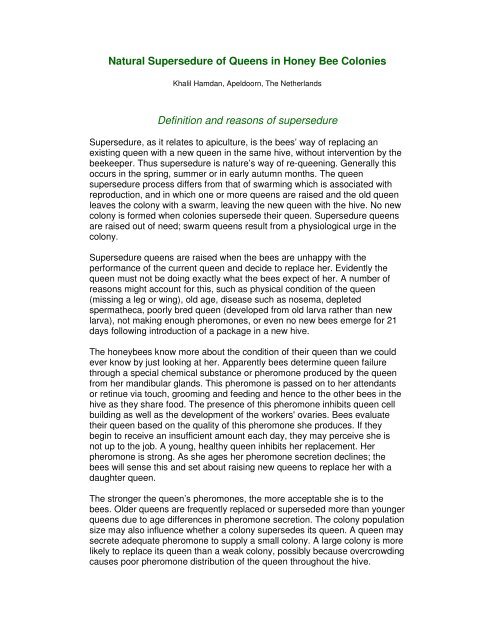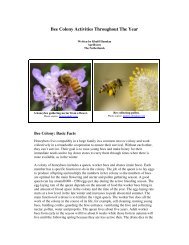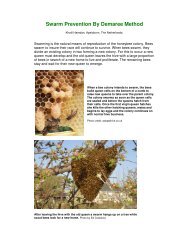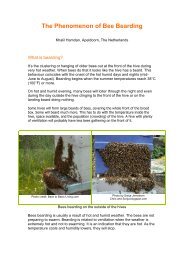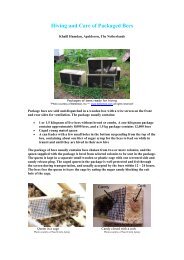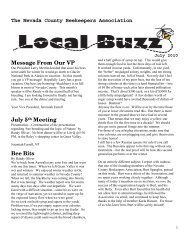Definition and reasons of supersedure
Natural Supersedure of Queens in Honey Bee ... - Country Rubes
Natural Supersedure of Queens in Honey Bee ... - Country Rubes
- No tags were found...
You also want an ePaper? Increase the reach of your titles
YUMPU automatically turns print PDFs into web optimized ePapers that Google loves.
Natural Supersedure <strong>of</strong> Queens in Honey Bee Colonies<br />
Khalil Hamdan, Apeldoorn, The Netherl<strong>and</strong>s<br />
<strong>Definition</strong> <strong>and</strong> <strong>reasons</strong> <strong>of</strong> <strong>supersedure</strong><br />
Supersedure, as it relates to apiculture, is the bees’ way <strong>of</strong> replacing an<br />
existing queen with a new queen in the same hive, without intervention by the<br />
beekeeper. Thus <strong>supersedure</strong> is nature’s way <strong>of</strong> re-queening. Generally this<br />
occurs in the spring, summer or in early autumn months. The queen<br />
<strong>supersedure</strong> process differs from that <strong>of</strong> swarming which is associated with<br />
reproduction, <strong>and</strong> in which one or more queens are raised <strong>and</strong> the old queen<br />
leaves the colony with a swarm, leaving the new queen with the hive. No new<br />
colony is formed when colonies supersede their queen. Supersedure queens<br />
are raised out <strong>of</strong> need; swarm queens result from a physiological urge in the<br />
colony.<br />
Supersedure queens are raised when the bees are unhappy with the<br />
performance <strong>of</strong> the current queen <strong>and</strong> decide to replace her. Evidently the<br />
queen must not be doing exactly what the bees expect <strong>of</strong> her. A number <strong>of</strong><br />
<strong>reasons</strong> might account for this, such as physical condition <strong>of</strong> the queen<br />
(missing a leg or wing), old age, disease such as nosema, depleted<br />
spermatheca, poorly bred queen (developed from old larva rather than new<br />
larva), not making enough pheromones, or even no new bees emerge for 21<br />
days following introduction <strong>of</strong> a package in a new hive.<br />
The honeybees know more about the condition <strong>of</strong> their queen than we could<br />
ever know by just looking at her. Apparently bees determine queen failure<br />
through a special chemical substance or pheromone produced by the queen<br />
from her m<strong>and</strong>ibular gl<strong>and</strong>s. This pheromone is passed on to her attendants<br />
or retinue via touch, grooming <strong>and</strong> feeding <strong>and</strong> hence to the other bees in the<br />
hive as they share food. The presence <strong>of</strong> this pheromone inhibits queen cell<br />
building as well as the development <strong>of</strong> the workers' ovaries. Bees evaluate<br />
their queen based on the quality <strong>of</strong> this pheromone she produces. If they<br />
begin to receive an insufficient amount each day, they may perceive she is<br />
not up to the job. A young, healthy queen inhibits her replacement. Her<br />
pheromone is strong. As she ages her pheromone secretion declines; the<br />
bees will sense this <strong>and</strong> set about raising new queens to replace her with a<br />
daughter queen.<br />
The stronger the queen’s pheromones, the more acceptable she is to the<br />
bees. Older queens are frequently replaced or superseded more than younger<br />
queens due to age differences in pheromone secretion. The colony population<br />
size may also influence whether a colony supersedes its queen. A queen may<br />
secrete adequate pheromone to supply a small colony. A large colony is more<br />
likely to replace its queen than a weak colony, possibly because overcrowding<br />
causes poor pheromone distribution <strong>of</strong> the queen throughout the hive.
Usually a queen that is being replaced through <strong>supersedure</strong> is failing in some<br />
way, perhaps is old <strong>and</strong> is deficient in egg laying. However, on occasions,<br />
bees will supersede young, vigorous <strong>and</strong> good laying queens. We cannot tell<br />
all the subtleties, such as level <strong>of</strong> queen pheromone, just by looking at the<br />
brood pattern. Maybe she is laying fine, but not producing enough<br />
pheromones to satisfy the bees <strong>of</strong> the hive, or she is infested with nosema or<br />
viruses. One will also, at times, observe a queen with a poor brood pattern,<br />
but who is still not being superseded. Perhaps she is still producing plenty <strong>of</strong><br />
queen pheromone <strong>and</strong> that is probably the most important factor. Perhaps<br />
there is nothing wrong with the queen. It could be that the queen is from<br />
highly hygienic stock. There may be mites, disease, or poisoning in the brood<br />
<strong>and</strong> the bees are cleaning up all the affected larvae <strong>and</strong> pupae so you don’t<br />
notice, or perhaps the colony does not perceive that the conditions are just<br />
now proper for replacing the queen <strong>and</strong> having her mate successfully.<br />
Queen raising by honeybees<br />
Queens are naturally raised in three different circumstances: swarm queens,<br />
<strong>supersedure</strong> queens, <strong>and</strong> emergency queens.<br />
Queens are raised in specially constructed cells that start out as queen cups<br />
for the resident queen to lay eggs in. Queen cups are larger than the worker<br />
<strong>and</strong> drone cells <strong>and</strong> are oriented with the cell opening downward.<br />
Empty queen cups<br />
Photo source: Little eco footprints.com<br />
When the queen cup is occupied is called a queen cell. Queen cells that begin<br />
from a queen cup are either swarm cells or <strong>supersedure</strong> cells. After an egg is<br />
laid in a cup, the worker bees extend the cup into a queen cell in which the<br />
queen is raised. Worker bees do not extend the queen cups into queen cells<br />
unless they have had eggs laid in them. The completely constructed queen<br />
cell is somewhat shaped like a peanut pod, usually 25-29 mm (1-1½ inches)<br />
in length <strong>and</strong> hangs downwards from the comb.
end in the middle (see drawing below). When an emergency cell is opened,<br />
it can be seen that it has a worker cell base.<br />
Emergency cells are built anywhere that there are larvae or eggs, although a<br />
central position on the comb is common. They look smaller than queen cells<br />
for swarming or <strong>supersedure</strong>.<br />
Emergency queen cells raised by queenless hive from enlarged worker cells<br />
Supersedure cells occur when the colony has decided to replace the current<br />
queen. The <strong>supersedure</strong> cell is started as a natural queen cup. The colony<br />
raises only a few cells, commonly 1 to 3, <strong>and</strong> they tend to be nearly uniform in<br />
age. They are typically raised on the face <strong>of</strong> a brood comb <strong>and</strong> in the same<br />
comb, not along the comb edge <strong>and</strong> near the bottom bars like swarm cells.<br />
These cells are usually long <strong>and</strong> heavily covered with beeswax. Supersedure<br />
cells can occur any time in the active season when a queen is failing.<br />
In the process <strong>of</strong> natural <strong>supersedure</strong> a new queen develops, while the old<br />
one continues to lay eggs. The old queen is not killed until the new queen has<br />
successfully mated <strong>and</strong> begun egg laying. This toleration <strong>of</strong> the old queen<br />
may be a safeguard, ensuring the presence <strong>of</strong> a laying queen, in the event <strong>of</strong><br />
the virgin queen fails to return from her mating flight.<br />
In some cases, the young, new queen <strong>and</strong> the old one may both live in the<br />
hive in harmony for some time, but generally the old queen is killed at the end
<strong>of</strong> the <strong>supersedure</strong>. It is not known whether she dies a natural death or is<br />
killed by the young queen or by the bees.<br />
Supersedure queen cells do not require any intervention from the beekeepers,<br />
except to leave them alone <strong>and</strong> let the <strong>supersedure</strong> run its course. The bees<br />
know something is wrong with the queen <strong>and</strong> want to correct it.<br />
Two <strong>supersedure</strong> queen cells on the comb face<br />
Photo by Richard Underhill<br />
Well formed <strong>supersedure</strong> queen cell in the center <strong>of</strong> brood comb<br />
Photo by Mark Gretchen. Queen cell/beeranch.wordpress.com
The original queen circled in green <strong>and</strong> her replacement circled in red, both are laying eggs<br />
on the same frame following <strong>supersedure</strong><br />
Photo by Micheál Mac Giolla Coda<br />
Swarm cells are the most common type, built from queen cups for raising<br />
new queens when the bees preparing to swarm. Swarm cells are the most<br />
numerous; about six to twelve are generally produced. Some colonies build<br />
up to 50 <strong>of</strong> them. These cells are typically located on the bottom portion <strong>of</strong> the<br />
comb or in gaps in the comb within the brood area. In general, several cells<br />
are started at intervals during a period <strong>of</strong> several days <strong>and</strong> are seen at various<br />
stages <strong>of</strong> development.<br />
Swarm cells on the bottom <strong>of</strong> a comb<br />
Photo by George Smichinski
Natural Supersedure – Is it Good or Bad?<br />
• Queens raised as a result <strong>of</strong> <strong>supersedure</strong> are <strong>of</strong>ten <strong>of</strong> good quality<br />
since they receive larger quantities <strong>of</strong> royal jelly during development.<br />
Capped <strong>supersedure</strong> cells can be cut out <strong>and</strong> used in making new<br />
nucleus colonies or requeening.<br />
• The hive will have a new queen. A very young queen is a better laying<br />
queen than an older queen <strong>and</strong> has the ability to produce enough <strong>of</strong><br />
her pheromone to spread over all the bees in a large colony.<br />
• Colonies that have just superseded rarely swarm unless the colony is<br />
overcrowded <strong>and</strong> does not have enough space. This is a very<br />
important matter from the beekeeper’s st<strong>and</strong>point.<br />
• Good stock can come from superseded queens but you may also get<br />
an aggressive mix. If you have a pure queen <strong>and</strong> she is superseded,<br />
her daughter will have 1/2 <strong>of</strong> her genetics passed on to her <strong>of</strong>fspring.<br />
The drones she mates with will provide the other 1/2. Thus, if she<br />
mates with drones <strong>of</strong> other races, the bees she produces will be hybrid<br />
because they will have genetic material from both parents.<br />
• Natural <strong>supersedure</strong> is done by the bees when there is something<br />
wrong with the queen. This means the colony is not at peak potential<br />
<strong>and</strong> will not be until they get a new queen (about 30 days).<br />
How to prevent <strong>supersedure</strong><br />
A well mated <strong>and</strong> healthy queen bee should have a life expectancy <strong>of</strong> three to<br />
five years. Then she has to be replaced or the queen will run out <strong>of</strong> sperm, the<br />
colony will become queenless, <strong>and</strong> it will perish.<br />
The best practice to prevent the colony from initiating <strong>supersedure</strong> is by<br />
requeening the colony every year, or at least every other year.<br />
When you replace the old queen yourself with one that is purchased from a<br />
reputable queen breeder, the queens <strong>and</strong> drones come from “gentle stock”.<br />
When your <strong>supersedure</strong> queen (probably <strong>of</strong> good queen stock) flies <strong>of</strong>f to<br />
mate, you have no control over the drones with which she is mating. They<br />
may or may not be from stocks that you want in your hives.


